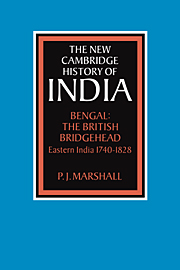Book contents
- Frontmatter
- 1 The setting for empire
- 2 Late Mughal Bengal
- 3 The crisis of empire, 1740–65
- 4 The new regime
- 5 A new society?
- 6 Conclusion
- Bibliographical Essay
- Index
- THE CAMBRIDGE HISTORY OF INDIA
- Map 1 Eastern India, 1740–1828: places mentioned in the text
- Map 2 Eastern India, 1740–1828: economic
- Plate Section">
- References
5 - A new society?
Published online by Cambridge University Press: 28 March 2008
- Frontmatter
- 1 The setting for empire
- 2 Late Mughal Bengal
- 3 The crisis of empire, 1740–65
- 4 The new regime
- 5 A new society?
- 6 Conclusion
- Bibliographical Essay
- Index
- THE CAMBRIDGE HISTORY OF INDIA
- Map 1 Eastern India, 1740–1828: places mentioned in the text
- Map 2 Eastern India, 1740–1828: economic
- Plate Section">
- References
Summary
The regime described in Chapter 4 may not have been a fully effective instrument for transmitting to eastern India the dynamism of late eighteenth- and early nineteenth-century Britain, whether that dynamism be regarded as predatory and destructive or as potentially regenerative. But through their military power, their commercial activities, their tax collecting, their choice of allies and subordinates, their interpretation of justice and even their experiments with education and Christian indoctrination, the British had a considerable capacity to change the societies with which they came into contact. Changes between 1765 and 1828 were manifold. Yet, as Chapter 1 tries to indicate, colonial rule is not in itself a sufficient explanation for change. The new regime was established in societies that were undergoing ecological, cultural, social and economic changes, which had begun long before 1765. Phenomena such as the commercialisation of some parts of agriculture, a brisk circulation of rights to collect revenue, and the stratification of cultivators into rich and poor, which are sometimes attributed to the British, were clearly present in the Bengal of the Nawabs. Realistic assessment of the impact of the new order requires recognition of the limitations on the capacity of the British, as well as awareness of their potential to change society. It seems much more likely that early British rule stimulated, modified or aborted existing patterns of change than that it was able to break long continuities and force eastern India into wholly new directions.
Keywords
- Type
- Chapter
- Information
- Bengal: The British BridgeheadEastern India 1740–1828, pp. 137 - 179Publisher: Cambridge University PressPrint publication year: 1988



